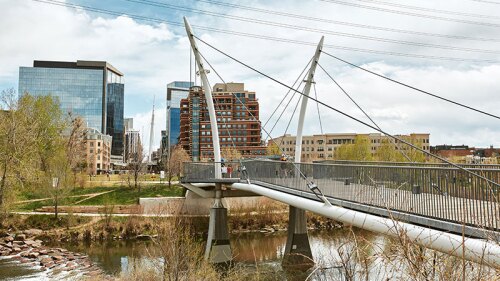With the 2012 Summer Olympic Games approaching, and a number of infrastructure and urban regeneration initiatives on the horizon, London presents opportunities for all investors—from those seeking core returns to those with an appetite for risk. Thanks to its transparency, international investment is a solid feature of the property market, maintaining its presence even in the depth of the financial crisis. Overseas investors spent almost £10 billion on commercial property in 2008 and 2009, and accounted for half of all investment into central London in the first half of 2011, according to European property adviser BNP Paribas Real Estate.
BNP Paribas chairman and ULI member Greg Cooke cites the arrival of Westfield’s Stratford City, a 4 million-square-foot (372,000-sq-m) regeneration project in East London, combined with the coming of the Olympics, as a potential hotspot of opportunity. “At the moment, it’s very much development-led, so [it’s] not suitable for risk-averse investors who are looking for income stream on day one,” he says. Below, Cooke identifies his top ten reasons for investing in London.
One: Demand
BNP Paribas estimates that there will be demand for at least 1.6 million square feet (148,800 sq m) of extra space in London over the next three years. An average of 3.1 million square feet (288,300 sq m) of space has been transacted each year by the financial sector over the past five years. This has been driven by lease expiries and merger-and-acquisition activity—a trend that is expected to continue.
Two: Demand Matches Supply
Small-scale financial companies currently occupying space of less than 10,000 square feet (930 sq m) will drive demand over the next few years, as they are more positive about job growth, which is “good news for the central London office market as these requirements match the supply available,” says Cooke.
Three: Shielded from the Crisis
The diversity of London’s investment market has shielded it from the worst effects of the financial crisis. Overseas investment is a key source of capital: non-U.K. investors accounted for 60 percent of the £10.3 billion transacted in central London over the past 18 months, according to BNP Paribas’ calculations.
Four: Business Confidence at a High
As London prepares for the Olympics, the confidence of overseas business in the capital is at a high. A survey commissioned by promotional agency London & Partners found that 90 percent of senior executives from overseas companies believe that London provides a good location for their business. A total of 86 percent said the Olympics would benefit London, while 70 percent said the proximity to markets and customers was a principal reason for their presence.
Five: Housing Market Has Held Up Well
London’s residential market is outperforming the rest of the U.K. The prime housing market recorded prices 30 percent above the 2007 peak this year, as overseas investors sought luxury property. “Despite the fact that the U.K. has austerity measures in place, it is seen as a strong market and a safe place for investors to put their cash,” Cooke says.
Six: Retail Continues to Be Robust
London’s retail property market has experienced a period of strong growth, driven by a favorable exchange rate for tourists and international retailers competing for space. Retailers from the United States are leading the international expansion; investment from China has appeared, too.
Seven: Demand for Hotels Remains Solid
Year-on-year profitability levels at London hotels increased by nearly 17 percent as the capital hosted an assortment of sporting, cultural, and political events. Overseas buyers, including Far Eastern and European investors, have dominated the London hotel market over the past 18 months, accounting for 70 percent of investment by value.
Eight: Attractive Tax Regime
London offers overseas investors an attractive tax regime. There is generally no U.K. tax on capital gains for non-U.K. resident investors buying property in London.
Nine: Transparency
The simplicity and efficiency of the U.K. legal system and market practices mean that investors are able to access accurate market information about particular assets, as well as about the market in general. “The liquidity of the London market means that entry and exit are always possible,” notes Cooke.
Ten: Longer Leases
Lease lengths in London average 6.7 years for offices and 7.7 years for retail. “Overseas investors appreciate the fact that buildings are often occupied by a sole tenant that is there for the long term, making it simpler to asset-manage a property from afar.”
Where to Invest
West End: London’s West End property market offers investors luxury hotels and residential, good-quality offices, as well as high-street and high-end retail. “Property here is smaller in scale relative to [that in] other areas—if you want to spend £200 million, the City may be your best bet, but if it’s £20 million there are lots of opportunities here,” Cooke says.
Safe and robust, the West End has fewer peaks and troughs than other London markets. Established prime locations are St. James’s, Mayfair, and Berkeley Square, where prime yields are 4 percent for offices and 3 percent for retail. “For those with an appetite for higher returns and interesting opportunities, areas such as Victoria, Paddington, north of Oxford Street, and Soho are worth a look,” he adds.
The City: “If you have large amounts of capital to deploy, this area should be top of your list,” according to Cooke. While the City offers a range of lot sizes, there are many properties measuring 200,000 square feet (18,600 sq m) and larger. With lease lengths averaging between five and 15 years compared with between five and ten years for offices in the West End, “this area is ideal for those looking for long-term income.”
The market can be volatile, however, not least because good scope for development in the City leads to fluctuating rental cycles. Current supply is being absorbed, decreasing from 11.71 million square feet (1.9 million sq m) in 2009 to 7.86 million square feet (730,980 sq m) in the second quarter of 2011.
Prime areas include EC2, EC3, and EC4, while “property in emerging areas at the fringes, such as Farringdon and Spitalfields, can provide investors with more interesting returns.”
Mid-Town: This market is a mix of the West End’s historical buildings and new modern space that can be found in the City. Deals tend to be between £20 million and £50 million. Multitenanted buildings provide good asset management opportunities for investors. Rental growth and income in Mid-Town’s office market outperformed those of both the City and the West End in 2010, according to the Investment Property Databank, a body that provides performance and risk analysis for real estate.
Prime property in Mid-Town can be found in Covent Garden and the Strand. “For more value-added opportunities, look north of Theobalds Road and around High Holborn,” recommends Cooke. Tottenham Court Road is also set to benefit from the large Crossrail development.




